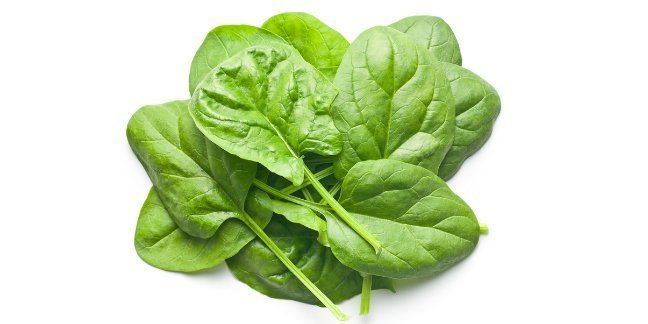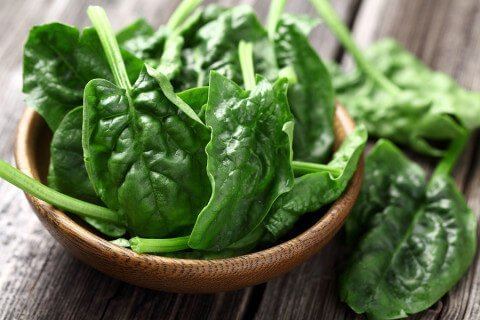Species S. oleracea | ||
 | ||
Similar Broccoli, Vegetable, Tomato, Kale, Onion | ||
Crackling spinach recipe by sanjeev kapoor healthy vegetarian dishes
Spinach (Spinacia oleracea) is an edible flowering plant in the family Amaranthaceae native to central and western Asia. Its leaves are eaten as a vegetable.
Contents
- Crackling spinach recipe by sanjeev kapoor healthy vegetarian dishes
- Vegetarian spinach stir fry dishes
- Etymology
- History
- Nutrition
- Iron
- Calcium
- Types of spinach
- Production marketing and storage
- In popular culture
- References

It is an annual plant (rarely biennial) growing to 30 cm (12 in) tall. Spinach may survive over winter in temperate regions. The leaves are alternate, simple, ovate to triangular, and very variable in size from about 2–30 cm (1–12 in) long and 1–15 cm (0.4–5.9 in) broad, with larger leaves at the base of the plant and small leaves higher on the flowering stem. The flowers are inconspicuous, yellow-green, 3–4 mm (0.1–0.2 in) in diameter, maturing into a small, hard, dry, lumpy fruit cluster 5–10 mm (0.2–0.4 in) across containing several seeds.

Common spinach, S. oleracea, was long considered to be in the family Chenopodiaceae, but in 2003, that family was merged into the family Amaranthaceae in the order Caryophyllales. Within the family Amaranthaceae sensu lato, Spinach belongs to subfamily Chenopodioideae.
Vegetarian spinach stir fry dishes
Etymology

The English word "spinach" dates to the late 14th century, and is from espinache (Fr. épinard), of uncertain origin. The traditional view derives it from O.Prov. espinarc, which perhaps is via Catalan espinac, from Andalusian Arabic اسبيناخ asbīnākh, from Arabic السبانخ al-sabānikh, from Persian اسپاناخ aspānākh, meaning purportedly 'green hand', but the multiplicity of forms makes the theory doubtful.
History

Spinach is thought to have originated in ancient Persia (modern Iran and neighboring countries). It is not known by whom, or when, spinach was introduced to India, but the plant was subsequently introduced to ancient China, where it was known as "Persian vegetable" (bōsī cài; 波斯菜; present:菠菜). The earliest available record of the spinach plant was recorded in Chinese, stating it was introduced into China via Nepal (probably in 647 AD).

In AD 827, the Saracens introduced spinach to Sicily. The first written evidence of spinach in the Mediterranean was recorded in three 10th-century works: the medical work by al-Rāzī (known as Rhazes in the West) and in two agricultural treatises, one by Ibn Waḥshīyah and the other by Qusṭus al-Rūmī. Spinach became a popular vegetable in the Arab Mediterranean and arrived in Spain by the latter part of the 12th century, where it was called raʼīs al-buqūl, 'the chieftain of leafy greens'. Spinach was also the subject of a special treatise in the 11th century by Ibn Ḥajjāj.
The prickly-seeded form of spinach was known in Germany by no later than the 13th century, though the smooth-seeded form was not described until 1552.
Spinach first appeared in England and France in the 14th century, probably via Spain, and it gained quick popularity because it appeared in early spring, when other vegetables were scarce and when Lenten dietary restrictions discouraged consumption of other foods. Spinach is mentioned in the first known English cookbook, the Forme of Cury (1390), where it is referred to as 'spinnedge' and/or 'spynoches'. Smooth-seeded spinach was described in 1552.
Spinach was supposedly the favourite vegetable of Catherine de' Medici. Dishes served on a bed of spinach are known as "Florentine", reflecting Catherine's birth in Florence.
During World War I, wine fortified with spinach juice was given to French soldiers weakened by hemorrhage.
Nutrition
In a 100 g (3.5 oz) serving providing only 23 calories, spinach has a high nutritional value, especially when fresh, frozen, steamed, or quickly boiled. It is a rich source (20% or more of the Daily Value, DV) of vitamin A, vitamin C, vitamin K, magnesium, manganese, iron and folate (table). Spinach is a good source (10-19% of DV) of the B vitamins riboflavin and vitamin B6, vitamin E, calcium, potassium, and dietary fiber.
Iron
Spinach, along with other green, leafy vegetables, contains an appreciable amount of iron attaining 21% of the Daily Value in a 100 g (3.5 oz) amount of raw spinach (table). For example, the United States Department of Agriculture states that a 100 g (3.5 oz) serving of cooked spinach contains 3.57 mg of iron, whereas a 100 g (3.5 oz) ground hamburger patty contains 2.49 mg. However, spinach contains iron absorption-inhibiting substances, including high levels of oxalate, which can bind to the iron to form ferrous oxalate and render much of the iron in spinach unusable by the body. In addition to preventing absorption and use, high levels of oxalates remove iron from the body.
Calcium
Spinach also has a moderate calcium content which can be affected by oxalates, decreasing its absorption. The calcium in spinach is among the least bioavailable of food calcium sources. By way of comparison, the human body can absorb about half of the calcium present in broccoli, yet only around 5% of the calcium in spinach.
Types of spinach
A distinction can be made between older varieties of spinach and more modern ones. Older varieties tend to bolt too early in warm conditions. Newer varieties tend to grow more rapidly, but have less of an inclination to run up to seed. The older varieties have narrower leaves and tend to have a stronger and more bitter taste. Most newer varieties have broader leaves and round seeds.
The three basic types of spinach are:
Production, marketing, and storage
In 2014, the world total production of spinach was 24.3 million tonnes, with China alone accounting for 91% of this quantity.
The Environmental Working Group reported spinach is one of the dozen most heavily pesticide-contaminated produce products. Depending on the soil and location where the spinach is grown, spinach may be high in cadmium contamination.
Spinach is sold loose, bunched, packaged fresh in bags, canned, or frozen. Fresh spinach loses much of its nutritional value with storage of more than a few days. While refrigeration slows this effect to about eight days, spinach will lose most of its folate and carotenoid content, so for longer storage, it is blanched and frozen, cooked and frozen, or canned. Storage in the freezer can be for up to eight months.
Spinach is packaged in air, or in nitrogen gas to extend shelf life. Some packaged spinach is exposed to radiation to kill any harmful bacteria that may be on the leaves. The Food and Drug Administration approves of irradiation of spinach leaves up to 4.0 kilograys; however, using radiation to sanitize spinach is of concern because it may deplete the leaves of their nutritional value. Researchers at the Agricultural Research Service experimentally tested the concentrations of vitamins C, E, K, B9, and four carotenoids in packaged spinach following irradiation. They found with increasing level of irradiation, four nutrients showed little or no change. Those nutrients include vitamins B9, E, K, and the carotenoid neoxanthin. This study showed the irradiation of packaged spinach to have little or no change to the nutritional value of the crop, and the health benefits of irradiating packed spinach to reduce harmful bacteria seem to outweigh the loss of nutrients.
In popular culture
The comics and cartoon character Popeye the Sailor Man has been portrayed since 1931 as having a strong affinity for spinach, becoming physically stronger after consuming it. The commonly accepted version of events states this portrayal was based on faulty calculations of the iron content. In this version, German scientist Emil von Wolff misplaced a decimal point in an 1870 measurement of spinach's iron content, leading to an iron value ten times higher than it should have been, and this faulty measurement was not noticed until the 1930s. This caused the popular misconception that spinach is exceedingly high in iron that makes the body stronger.
Criminologist Mike Sutton wrote an article in the Internet Journal of Criminology, claiming the Popeye and iron link is just another long-standing myth, and spinach was chosen and promoted in Popeye for its vitamin A content alone. In the cited article, he also disputes the above — what he calls the 'Spinach Popeye Iron Decimal Error Story (SPIDES)' — due to lack of verifiable sources, although he found a different reference from 1934 reporting 20 times the actual iron content. In another article, Sutton distinguishes between the myth of spinach's iron content, which he blames on "bad science", and the myth that the error was caused by a misplaced decimal point.
